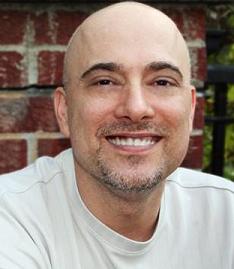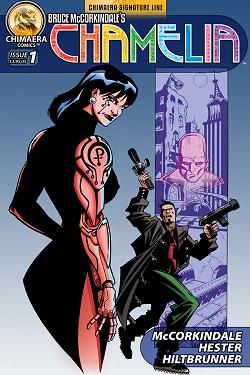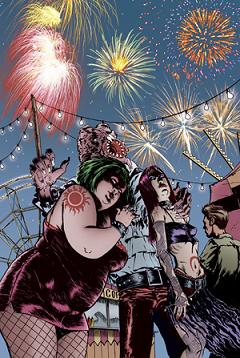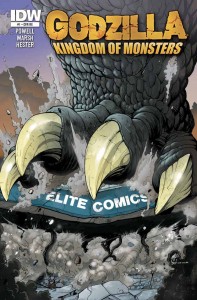 Writer. Penciller. Inker. Animator. Bruce McCorkindale has got you covered. He’s a multi-talented type from Omaha, Nebraska. His comics credits include writer/artist turns on The Falling Man, Negative Burn, and Chamelia. You’ve also seen his inking work on Star Trek: Deep Space Nine, Black Orchid, The Wretch, Rune Vs. Venom, Marvel Time Slip, and the current Image Comics series Golly! He also produces animation through his Action Impulse Studios.
Writer. Penciller. Inker. Animator. Bruce McCorkindale has got you covered. He’s a multi-talented type from Omaha, Nebraska. His comics credits include writer/artist turns on The Falling Man, Negative Burn, and Chamelia. You’ve also seen his inking work on Star Trek: Deep Space Nine, Black Orchid, The Wretch, Rune Vs. Venom, Marvel Time Slip, and the current Image Comics series Golly! He also produces animation through his Action Impulse Studios.
His most recent efforts include Golly!, The Falling Man, and Chamelia. Find out more about Bruce at www.brucemccorkindale.com and www.actionimpulse.com.
Question 1: When did you first decide that you wanted to create your own comics for a living?
When I was eight, during a summer vacation at my grandparents’ cabin in Minnesota. I read a huge pile of Marvel comics, filled up a 200+ page tablet with my own comics, and decided on the ride home that there was no other career.
Question 2: Who has had the biggest influence on you outside the comics industry, and how did they affect your life?
My parents, for being so encouraging about such an improbable and impractical career as comics. It’s amazing how fast kids can be discouraged with a small word or two, and I never heard discouraging word one.
Question 3: Who has had the biggest influence on your comics career, and how has that person changed your work?
 Jack Kirby. I’ve never taken acid, but I’ve heard people say that after you’ve done it, you never perceive things quite the same way. That’s how I felt about Jack’s work. It was like the creative equivalent of a big bang.
Jack Kirby. I’ve never taken acid, but I’ve heard people say that after you’ve done it, you never perceive things quite the same way. That’s how I felt about Jack’s work. It was like the creative equivalent of a big bang.
Question 4: What do you do to recharge your creative batteries?
Try something new. I have certain habits and patterns that are sort of necessary to get the work done, but it can also lead to redundancy. Sometimes I like to try working in a style that isn’t comfortable, and get a new perspective.
Question 5: Describe your typical work routine.
I work on a lot of different types of projects, so it’s hard to have a typical routine. One day I might be writing, penciling, inking, coloring, or lettering. I also do a lot of animation for my commercial studio, Action Impulse Studios, so that can take me into a whole different world. The only thing typical in my routine is insanely long hours.
Question 6: What writing, drawing, or other tools do you use?
It’s a pretty interesting split between natural media and digital tools. One day I might be inking an illustration with a 50-year old pen point that I found on eBay, and the next day I might be digitally “inking†Brook Turner’s pencil art for Golly! in Photoshop. I really enjoy traditional media and digital media about evenly.
 Question 7: What element of your work gives you the most personal satisfaction?
Question 7: What element of your work gives you the most personal satisfaction?
The storytelling, whether that’s with prose or pictures. My scripting output has been surprisingly light, given this preference, but I’m constantly trying to rectify that. Right now, I’m having a lot of fun writing and illustrating a three-issue series for Chimaera, Chamelia. The similarity of names is purely coincidence.
Question 8: What has been the most rewarding project in your professional career – in or out of comics – and why?
Actually, it might be the aforementioned Chamelia project! It was daunting to actually write, illustrate, color, and letter an entire book, and I was pretty happy with the way it turned out. On a purely geek level, it was kind of mind-blowing, early on, to ink a Curt Swan story. His Superman was probably one of the very first things I ever read, so my hands actually shook before I laid ink on his stuff. It was exciting.
Question 9: We’ve all met very talented newcomers who are trying to get their first professional projects. What’s the best advice you’ve ever heard given to a promising new creator?
Trust your own voice. I heard this advice early on from comic art professionals at conventions, and also from instructors at college when I was studying creative writing. It’s advice that has slipped in and out of my own consciousness over the years, and I would encourage others to never forget it.
Question 10: Time to get philosophical: What’s the most important “big idea” that you’ve learned in life – in or out of comics – and why is it important?
Balance. It’s a big theme in my book The Falling Man, and it’s another of those big ideas that I can’t seem to make stick in my own life. It’s great to hone and perfect your art, but if you don’t have a real life on the other side to draw from, then the art — and everything else — is going to suffer.
Want more? See the index of “10 Questions” interviews.
Discuss “10 Questions” in the ComicsCareer.Com Forum.
Are you a professional comics creator? Participate in the 10 Questions project.

 Writer. Penciller. Inker. Animator. Bruce McCorkindale has got you covered. He’s a multi-talented type from Omaha, Nebraska. His comics credits include writer/artist turns on The Falling Man, Negative Burn, and Chamelia. You’ve also seen his inking work on Star Trek: Deep Space Nine, Black Orchid, The Wretch, Rune Vs. Venom, Marvel Time Slip, and the current Image Comics series Golly! He also produces animation through his Action Impulse Studios.
Writer. Penciller. Inker. Animator. Bruce McCorkindale has got you covered. He’s a multi-talented type from Omaha, Nebraska. His comics credits include writer/artist turns on The Falling Man, Negative Burn, and Chamelia. You’ve also seen his inking work on Star Trek: Deep Space Nine, Black Orchid, The Wretch, Rune Vs. Venom, Marvel Time Slip, and the current Image Comics series Golly! He also produces animation through his Action Impulse Studios.
